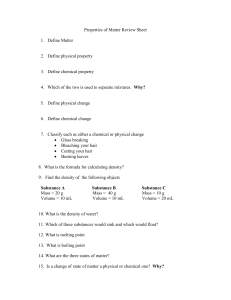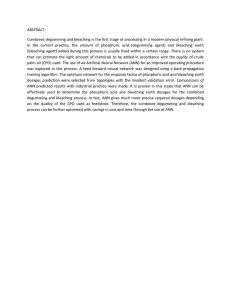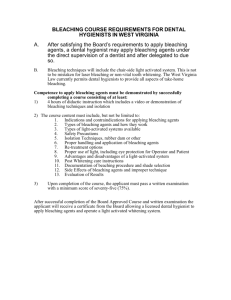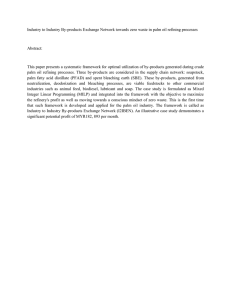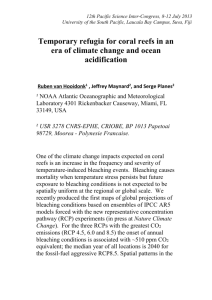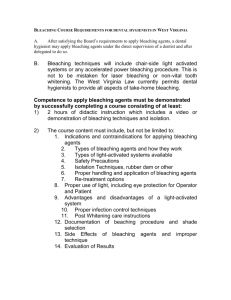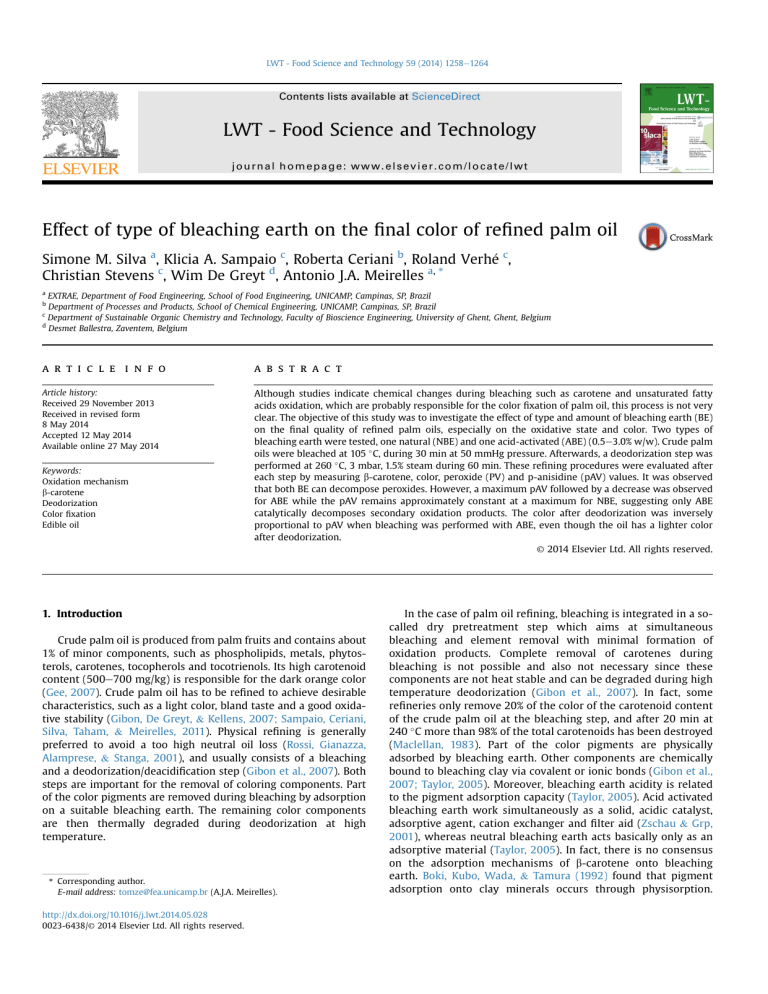
LWT - Food Science and Technology 59 (2014) 1258e1264 Contents lists available at ScienceDirect LWT - Food Science and Technology journal homepage: www.elsevier.com/locate/lwt Effect of type of bleaching earth on the final color of refined palm oil c, Simone M. Silva a, Klicia A. Sampaio c, Roberta Ceriani b, Roland Verhe c d a, * Christian Stevens , Wim De Greyt , Antonio J.A. Meirelles a EXTRAE, Department of Food Engineering, School of Food Engineering, UNICAMP, Campinas, SP, Brazil Department of Processes and Products, School of Chemical Engineering, UNICAMP, Campinas, SP, Brazil c Department of Sustainable Organic Chemistry and Technology, Faculty of Bioscience Engineering, University of Ghent, Ghent, Belgium d Desmet Ballestra, Zaventem, Belgium b a r t i c l e i n f o a b s t r a c t Article history: Received 29 November 2013 Received in revised form 8 May 2014 Accepted 12 May 2014 Available online 27 May 2014 Although studies indicate chemical changes during bleaching such as carotene and unsaturated fatty acids oxidation, which are probably responsible for the color fixation of palm oil, this process is not very clear. The objective of this study was to investigate the effect of type and amount of bleaching earth (BE) on the final quality of refined palm oils, especially on the oxidative state and color. Two types of bleaching earth were tested, one natural (NBE) and one acid-activated (ABE) (0.5e3.0% w/w). Crude palm oils were bleached at 105 C, during 30 min at 50 mmHg pressure. Afterwards, a deodorization step was performed at 260 C, 3 mbar, 1.5% steam during 60 min. These refining procedures were evaluated after each step by measuring b-carotene, color, peroxide (PV) and p-anisidine (pAV) values. It was observed that both BE can decompose peroxides. However, a maximum pAV followed by a decrease was observed for ABE while the pAV remains approximately constant at a maximum for NBE, suggesting only ABE catalytically decomposes secondary oxidation products. The color after deodorization was inversely proportional to pAV when bleaching was performed with ABE, even though the oil has a lighter color after deodorization. © 2014 Elsevier Ltd. All rights reserved. Keywords: Oxidation mechanism b-carotene Deodorization Color fixation Edible oil 1. Introduction Crude palm oil is produced from palm fruits and contains about 1% of minor components, such as phospholipids, metals, phytosterols, carotenes, tocopherols and tocotrienols. Its high carotenoid content (500e700 mg/kg) is responsible for the dark orange color (Gee, 2007). Crude palm oil has to be refined to achieve desirable characteristics, such as a light color, bland taste and a good oxidative stability (Gibon, De Greyt, & Kellens, 2007; Sampaio, Ceriani, Silva, Taham, & Meirelles, 2011). Physical refining is generally preferred to avoid a too high neutral oil loss (Rossi, Gianazza, Alamprese, & Stanga, 2001), and usually consists of a bleaching and a deodorization/deacidification step (Gibon et al., 2007). Both steps are important for the removal of coloring components. Part of the color pigments are removed during bleaching by adsorption on a suitable bleaching earth. The remaining color components are then thermally degraded during deodorization at high temperature. * Corresponding author. E-mail address: tomze@fea.unicamp.br (A.J.A. Meirelles). http://dx.doi.org/10.1016/j.lwt.2014.05.028 0023-6438/© 2014 Elsevier Ltd. All rights reserved. In the case of palm oil refining, bleaching is integrated in a socalled dry pretreatment step which aims at simultaneous bleaching and element removal with minimal formation of oxidation products. Complete removal of carotenes during bleaching is not possible and also not necessary since these components are not heat stable and can be degraded during high temperature deodorization (Gibon et al., 2007). In fact, some refineries only remove 20% of the color of the carotenoid content of the crude palm oil at the bleaching step, and after 20 min at 240 C more than 98% of the total carotenoids has been destroyed (Maclellan, 1983). Part of the color pigments are physically adsorbed by bleaching earth. Other components are chemically bound to bleaching clay via covalent or ionic bonds (Gibon et al., 2007; Taylor, 2005). Moreover, bleaching earth acidity is related to the pigment adsorption capacity (Taylor, 2005). Acid activated bleaching earth work simultaneously as a solid, acidic catalyst, adsorptive agent, cation exchanger and filter aid (Zschau & Grp, 2001), whereas neutral bleaching earth acts basically only as an adsorptive material (Taylor, 2005). In fact, there is no consensus on the adsorption mechanisms of b-carotene onto bleaching earth. Boki, Kubo, Wada, & Tamura (1992) found that pigment adsorption onto clay minerals occurs through physisorption. S.M. Silva et al. / LWT - Food Science and Technology 59 (2014) 1258e1264 Sabah, Cinar, & Celik (2007) suggested that b-carotene adsorption onto sepiolite is also physical. On the other hand, according to Khoo, Morsingh, & Liew (1979), b-carotene adsorption onto different commercial bleaching earths is not purely physical. Later, other works found that b-carotene adsorption onto acid activated bleaching earth (Sarier & Guler, 1988) and onto silica gel (Ahmad, Chan, Shukor, & Mashitah, 2009) was controlled by chemisorption. It is well accepted that there is no correlation between the bcarotene content after bleaching and the palm oil final color (Dijkstra & Segers, 2007; Fraser & Frankl, 1981; Maclellan, 1983). Some studies suggest that in the finished oil, the color is mostly due to high molecular weight (HMW) compounds derived from oxidation reactions, especially in the case of carotenoids (Fraser & Frankl, 1981). Also, aggressive bleaching conditions, as excessive temperatures or time process or both, lead to darker final colors (Maclellan, 1983). Recently, there are several research groups studying b-carotene oxidation in lipid/organic systems (Benevides, Veloso, Pereira, & de Andrade, 2011; Bosser, Paplorey, & Belin, 1995; Rodriguez & Rodriguez-Amaya, 2007; Wache, Bosser-DeRatuld, Lhuguenot, & Belin, 2003; Zeb, 2012; Zeb & Murkovic, 2013a, 2013b) concerning b-carotene antioxidant activity, off-flavor compounds formation and synthesis. However, there is a lack in the literature in works concerning the b-carotene pathways during refining practices and its importance in the quality of fully refined oils. In this context, the goal of this work was to study the effect of the type of bleaching earth used during bleaching on the color of fully refined palm oil. Moreover, a hypothesis is proposed to explain how the type of bleaching earth can affect the oxidation pathways. 2. Material and methods 2.1. Oil characterization Standard quality parameters, including free fatty acids (FFA) content, color, carotene content, deterioration of bleachability index (DOBI) and element content, were analyzed for crude, bleached and full refined palm oil samples. 2.1.1. Color The sample color was determined according to the AOCS Official Method Cc 13e-92, using a Lovibond Tintometer Color Scale at 70 C, ensuring that color was determined in a completely melted sample. Analyses were carried out using 500 ¼ (133.4 mm) glass cells. In the cases of crude palm oil samples, the color was darker than scale in a 500 ¼ glass cell and a 100 (25.4 mm) was used (AOCS, 1998). 2.1.2. Free Fatty Acids (FFA) Free Fatty Acids content (FFA) was determined according to the AOCS Official Method Ca 5-40, by titration. Results were expressed as percentage of palmitic acid (C16:0, MW ¼ 256 g/mol) (AOCS, 1998). 2.1.3. Deterioration of the bleachability index (DOBI) The deterioration of bleachability index (DOBI) was measured using a UVevis spectrophotometer. This index corresponds to the ratio of the spectrophotometric absorbance at 446 nm (nonoxidized carotenes maximum) to the absorbance at 268 nm (oxidized carotenes maximum). About 0.1 mg of completely molten and homogenized oil is diluted in 25 mL of iso-octane. Absorbencies are measured at 268 nm and 446 nm. The DOBI value is obtained by Eq. (1). 1259 Table 1 Palm Oil Color, b-carotenes and elements content (mg/kg) after bleaching and deodorization using acid activated (ABE) and neutral (NBE) bleaching earths. ABE 0.5 NBE 1.0 3.0 0.5 1.0 3.0 After Bleaching Elements content (mg/kg) P 2.7 ± 0.1 0.5 ± 0.1 0.2 ± 0.1 3.1 ± 0.1 0.6 ± 0.1 0.2 ± 0.0 Fe 0.7 ± 0.1 0.2 ± 0.0 0.2 ± 0.0 0.5 ± 0.0 0.1 ± 0.0 0.2 ± 0.0 Carotenes 258 83 10 280 87 NDa (mg/kg)b Color (5 ¼ in) 68.0 42.0 15.8 68.0 39 12.5 Red (R) After deodorization Color (5 ¼ in) 8.2 7.3 3.4 9.1 8.4 6.1 Red (R) a b ND: Not detected. Carotenes were not detected in any sample after deodorization. DOBI ¼ absorbance at 446 nm absorbance at 268 nm (1) The higher the DOBI value, the lower the amount of oxidized carotenes, the more efficient it will be to heat bleach the oil, as color due to oxidized carotenes is difficult to remove. DOBI values between 2.5 and 4.0 indicate average to good crude oil quality. Values below 2.0 indicate a poor quality crude palm oil which is difficult to bleach. 2.1.4. Carotenes content Carotenes content, expressed as b-carotene, was determined measuring the absorbances at 446 nm of samples homogenized and diluted in iso-octane, according to PORIM (1990). 2.1.5. p-Anisidine and peroxide values Peroxide (PV) and p-anisidine (p-AnV) values were determined according to the AOCS Official Methods Cd 8-53 and Cd 18-90, respectively (AOCS, 1998). 2.1.6. Elements content The content of Phosphorus (P) and Iron (Fe) were measured using an Inductively Coupled Plasma (ICP) method, according to the AOCS official method Ca 20-99, using kerosene as solvent (AOCS, 1998). 2.2. Refining procedure Bleaching trials were performed according to the following steps: heating the crude palm oil to 85 C; adding citric acid (0.3% of a 30% solution); high shear mixing (16,000 rpm during 1 min); addition of Bleaching Earth; 15 min of maturation time at 85 C and atmospheric pressure; applying vacuum (50 mbar) and maintaining bleaching conditions for 30 min at 105e110 C and removing the bleaching earth by filtration over a Buchner filter (pore size 11 mm, Whatman). Experiments were performed using two kinds of bleaching earth: non-activated bleaching earth (Pure Flo B80, purchased from Oil-Dri, here so-called NBE) and acid activated bleaching earth (Tonsil OPT. 210 FF, purchased from Süd-Chemie AG, here so-called ABE). After bleaching, the oil was submitted to a deodorization step since some color effects can just be observed after heat bleaching. To avoid differences due to storage effects, the deodorization was always carried out one day after the bleaching. The deodorization 1260 S.M. Silva et al. / LWT - Food Science and Technology 59 (2014) 1258e1264 was performed in a lab-scale equipment described by Petrauskaite, De Greyt, and Kellens (2000). Deodorization parameters were fixed to all experiments and set as 260 C of deodorization temperature, 3.0 mbar, 1.5% steam and 60 min of residence time. 3. Results Crude palm oil (obtained from a local processor) was characterized regarding FFA, DOBI, color, carotenes and elements content (mg/kg). The DOBI value was 2.06 ± 0.01, indicating that the final color is difficult to predict after complete refining of the oil (Gibon et al., 2007). The initial content (mg/kg) of phosphorus, iron and carotenes was 19.1 ± 0.2, 7.4 ± 0.9 and 467 ± 2, respectively. The crude palm oil presented an initial FFA of 4.61%, expressed in palmitic acid, and 37.8 h OSI. A bleaching procedure was tested using both kinds of bleaching earth at three different concentrations: 0.5, 1.5 and 3.0% (Table 1). Phosphorus and iron contents lower than 3.0 and 0.3 mg/kg, respectively, were achieved by both bleaching earths when using 3.0%. ABE leads to a better reduction of phosphorus especially when small amounts of bleaching earth are used. However, increasing the amount, this effect becomes less important, and the phosphorus content obtained using each bleaching earth is quite similar. The opposite behavior was observed for iron adsorption. Concerning the carotenes analysis, it can be noted that for the lower concentration level tested, ABE resulted in a higher adsorption of carotene than NBE. Using larger quantities, NBE gives a higher adsorption. It was not possible to observe a relation between the carotene content after bleaching and the color after deodorization (Table 1), as suggested by Taylor (2005). Regarding the color, it can be noted that after bleaching using 0.5% led to 68.0 R for both BE. When a higher amount of BE was used, differences in color could be observed; NBE leads to an oil of about 3.0 R lighter then ABE after bleaching. After deodorization the oil bleached with ABE presents a lighter color, even though it was darker after bleaching. It is interesting to highlight that the carotene content and Lovibond color obtained after bleaching with ABE were higher than that obtained with NBE, however, it gave instead a lighter color after deodorization. The oxidative state of the oils after bleaching using ABE and NBE are presented in Fig. 1. For both bleaching earths, peroxides value decrease with BE concentration. Note that, amounts slightly higher than 1.0% ABE reduces the PV to zero, while for the NBE about 2.0% is necessary. Small amounts of BE increases the p-AnV. In the case of ABE, p-AnV increases and then starts to Fig. 1. Oxidative State of Bleached Oils: Relative Peroxide and p-Anisidine values (value/initial value) vs amount of bleaching earth (% w/w). (Legend: Peroxide value, ABE , NBE/p-Anisidine value, A ABE ◊ NBE). decrease back to the initial value. In the case of NBE, p-AnV shows an increasing trend up to an approximately constant value. It is interesting to note that maximum p-AnV values coincide with the point the peroxides value reaches zero for the first time, suggesting that the peroxides are being converted into secondary oxidation products. Different p-AnV values were obtained by adjusting the bleaching earth amount and by repeating the bleaching procedure in fully refined oils. A correlation between p-AnV after bleaching and palm oil color after deodorization was observed when ABE was used (Fig. 2). The same correlation was not observed for NBE. As a second part of this work, the effect of the amount of citric acid added during bleaching was evaluated. Citric acid can act in two ways during oil degumming: firstly, displacing phosphatidic acid (PA) in its salts; secondly, forming a chelating agent capable to form a stronger bond with alkaline earth than PA does (Dijkstra, 2010). Here, we assume that by adding more citric acid, more elements species can be chelated, reducing their concentration in the oil. Moreover, citric acid reduces the pH of the solution and competes with compounds to be adsorbed. The effect of the citric acid (added as 30% solution) was tested using 2.0% of bleaching earth (Table 2). Note that this represents an increase in citric acid and water addition. The oils showed a higher FFA after bleaching with ABE than those bleached with NBE. This can be due to the inherent acidity of ABE or due to a catalytic effect forming FFA. The phosphorus adsorption decreases with the amount of added citric acid for both bleaching earths, but the decrease is more significant with NBE. There is no difference between the final Iron content using the same bleaching earth. Concerning the carotenes content, increasing the citric acid concentration resulted in different behavior for each bleaching earth. In the case of ABE; adding more citric acid caused that more carotenes were adsorbed. On the other hand, when NBE was used as bleaching earth, the increasing amount of citric acid resulted in a lower adsorption of carotenes. It was not possible to observe any relation between the color after bleaching and after deodorization, as suggested by Fraser & Frankl (1981). In the case of ABE, the use of more citric acid leads to a lower color after bleaching but a higher color after deodorization. On the other hand, when NBE was used, more citric acid leads to a higher color after bleaching and a lower color after deodorization. From those results, it can be inferred that the chelating power is not the factor affecting the palm oil final color. A possible explanation is that the pH interferes in b-carotenes oxidation pathways, and this will be further discussed in the following section. Fig. 2. p-Anisidine value vs Colour in oils bleached with different amounts of bleaching earth (Legend: - ABE , NBE). S.M. Silva et al. / LWT - Food Science and Technology 59 (2014) 1258e1264 Table 2 Effect of citric acid and water amount during bleaching using 2.0% acid activated (ABE) and neutral (NBE) bleaching earths. ABE After Bleaching FFA (%) Elements content (mg/kg) P Fe Carotenes (mg/kg)a Color (5 ¼ in) Red (R) After deodorization Color (5 ¼ in) Red (R) a NBE 0.09% CA 0.27% CA 0.09% CA 0.27% CA 0.21% water 0.63% water 0.21% water 0.63% water 5.0 5.0 4.7 4.8 0.4 ± 0.1 0.2 ± 0.0 40 29.0 0.5 ± 0.1 0.2 ± 0.0 21 25.0 0.6 ± 0.0 0.3 ± 0.0 13 19.2 0.8 ± 0.1 0.3 ± 0.0 19 22.0 6.1 7.3 8.9 8.2 Carotenes were not detected in any sample after deodorization. 4. Discussion In this work, no correlation was found between the b-carotene concentration of crude oil and the final color of the palm oil. On the other hand, a high correlation was found between p-AnV after bleaching with ABE and the palm oil color after deodorization/heat bleaching. The same correlation was not observed when the bleaching was done with NBE. It is also interesting to highlight that heat bleaching was more efficient after bleaching with ABE, even though NBE was capable of removing more efficiently the color during bleaching. Oxidation of compounds such as b-carotenes may be an explanation for those results as described hereafter. Tonsil OPT 210 FF is an acid activated bleaching earth manufactured by acid activation of calcium bentonite. It has acidic and catalytic activity, leading most importantly to hydroperoxide decomposition, forming sub-products such as aldehydes, ketones and conjugated polyenes (Zschau & Grp, 2001). Pure Flo B 80 is a neutral bleaching earth with no catalytic activity. These properties can be confirmed through oxidative state data (Fig. 1). Note, for instance, a smaller amount of ABE is needed to reach zero peroxides compared to NBE. Furthermore, the first point presenting a maximum p-AnV value (secondary oxidation products) is correlated to the minimum PV value. Note also that ABE decreases p-AnV until a constant value and NBE keeps it constant at the maximum. Indeed, as suggested by Sarier & Guler (1988), b-carotene which remains in solution with acid activated bleaching earth is rapidly oxidized later on, even more than those submitted to oxygen for 48 h. Consequently, it may be said that acid activated bleaching earth initiates the oxidation of unadsorbed b-carotene. Carotenoids can react with radical species in three different ways, including (1) radical addition, (2) electron transfer to the radical or (3) allylic hydrogen abstraction (Bonnie & Choo, 1999). Which mechanism will take place depends on the reaction conditions. For instance, by increasing the oxygen concentration, the formation of secondary peroxyl radicals becomes important, resulting in the loss of antioxidant behavior. With a sufficiently high oxygen partial pressures (above 150 mmHg) (Burton & Ingold, 1984), b-carotene reactions have a pro-oxidant effect since they could generate more radicals than they consume (Krinsky & Yeum, 2003). Electron transfer reactions have been reported either in formation of a carotenoid cation CARþ, anion CAR or in the formation of an alkyl radical (Krinsky & Yeum, 2003), stable because of its resonance structure (Kamal-Eldin, 2003). Finally, allylic hydrogen abstraction by peroxyl radical occurs at an oxygen pressure of less than 760 mmHg, producing a carotene radical. Those 1261 radicals undergo addition of oxygen producing dicarbonyls (KamalEldin, 2003). It is clear, that allylic hydrogen abstraction does not occurs in bleaching conditions due to its moderate temperature and pressures, being always lower than 50 mbar. Moreover, b-carotene behaves differently in different oils and under different conditions, i.e. temperature and lipid system composition (Zeb & Murkovic, 2013b). Burton and Ingold (1984) suggested that b-carotene reacts with peroxyl groups by addition, rather than by hydrogen abstraction. Liebler & McClure (1996) identified radical adducts formed during b-carotene oxidation, which then combines with a second radical to form an addition product. The formation of alkyl- and alkoxyl-containing addition products indicates that both may add directly to b-carotene. In contrast, peroxyl radical addition yields an unstable intermediate radical adduct that collapses to an epoxide and releases an alkoxyl radical. The polarity of the medium determines the pathways that bcarotene oxidation undergoes: in nonpolar solvents, only addition radicals are formed, meanwhile in polar ones carotenoid radical cations are formed. For both solvents, the first product is an addition radical formed between the acylperoxyl radical and the carotenoid (Eq. (2), Fig. 3) (El-Agamey & McGarvey, 2003). In fact, the Gibbs free energy presents similar negative values for both system polarities, thus, the exergonicity of reactions depends mostly on the nature of the free radical, being OH radical the most exergonic and peroxyl radicals the least one (Martinez, Vargas, & Galano, 2010). Those radicals have no reactivity toward oxygen, even at high oxygen pressures as 760 mmHg (Eq. (3)) (El-Agamey & McGarvey, 2003). BC þ ROO / ROOBC (2) ROOBC þ O2 / ✕ (3) Subsequent steps of b-carotene oxidation follow different pathways for polar and non-polar solvents (Fig. 4). In non-polar solvents, the radicals decompose in epoxides and cyclic ethers, therefore, with an acyloxyl radical elimination (Eq. (4)) (El-Agamey & McGarvey, 2003), leading to volatile products such as apocarotenals (Krinsky & Yeum, 2003). Note that this reaction releases a radical, thus, showing no net consumption of radical, being an autoxidation reaction (Liebler, 1993). ROOBC þ ROO / “nonradical product” (4) Nonetheless, in polar solvents, an ion-pair composed by a peroxyl anion (ROO) and a cation (CARþ) is formed, which absorbs near-infrared radiation (El-Agamey & McGarvey, 2003) and after, it is transformed to carotenoid radical cation. Even though vegetable oil is nonpolar, BE negative sites may make a polar layer close to its Fig. 3. First Addition Radical formed in both polar and non polar media. 1262 S.M. Silva et al. / LWT - Food Science and Technology 59 (2014) 1258e1264 Fig. 4. b-carotene oxidation pathways using acid activated (ABE) and neutral (NBE) bleaching earths. surface, supporting reactions associated with polar environments. Negative charged sites of ABE can readily adsorb those cations. Indeed, cationic compounds are preferentially adsorbed by acidic centers of bleaching earth, as suggested by Zschau & Grp (2001), due to a chemisorption mechanism instead of physisorption (Kent, 2008). According to Silva et al. (2013), b-carotenes are chemisorbed by ABE. During the deodorization step, b-carotene degradation progress follows different mechanisms. Heat excited carotenoids undergo cisetrans isomerization or react with oxygen to form diradicals (Kamal-Eldin, 2003). According to Rodriguez & Rodriguez-Amaya (2007) both cis and trans carotenes are susceptible to oxidation. b-carotene can undergo autoxidation much easier than compounds containing fewer conjugated double bonds, as b-apo-80 -carotenal and retinal, due to transecis thermal isomerization. During twisting of the b-carotene backbone unpaired spin density will develop in each half of the molecule, reaching a maximum in the perpendicular transition state and forming cyclic peroxides which may self-initiate autoxidation reactions. The main stable products to thermal degradation are higher molecular weight components, epoxy-b-carotenes, apocarotenals and apo-carotenones, other low molecular weight di- and tri-oxygenated compounds, probably including carboxylic and/or peracids, and carbon dioxide (Mordi et al., 1993) (Fig. 5). Marty and Berset (1990) suggested b-carotene degrades by progressive shortening of the polyene chain by two carbon atoms at a time. So, oxidative break of a double bond in the bcarotene molecule leads to the formation of two carbonyl fragments of which one may be colorless. Benevides et al. (2011) studied b-carotene oxidation by ozone in organic model and demonstrated that the oxidized isomers formed depends on the oxidation agent. The effect of citric acid addition on the palm oil final color reinforces this hypothesis. The citric acid can induce an increasing competition among compounds to be adsorbed and reducing the solution pH. The increase of competition among compounds to be adsorbed has a negative effect, as it reduces the adsorption of P and Fe. This phenomenon is observed in Fig. 5. Products formed during b-carotene oxidation through radical addition. S.M. Silva et al. / LWT - Food Science and Technology 59 (2014) 1258e1264 processes using both BE, and the concentrations of those elements after processing with more citric acid are higher. The reduction of the pH can change the b-carotene pathways, as explained previously. In the case of the process using NBE, the use of more citric acid leads to a more polar environment and makes the formation of cations more favorable. The process using ABE shows an already sufficient low pH, so that even with less citric acid those reactions were promoted. In this way, the positive effect of the pH is more pronounced with NBE, whilst the negative effect of competition with ABE. Processing with NBE tends to have the same behavior as processing with ABE when more citric acid is added: lower carotenes adsorption, darker color after bleaching and lighter color after deodorization. This work presented important results to improve the understanding of palm oil refining and some concluding remarks can be drawn so far: the type of bleaching earth can define oxidation pathways in two different manners. At the first moment, ABE decomposes peroxides in alkoxyl and alkyl radicals, which can react faster with b-carotene. Later, ABE creates a more polar environment, supporting radical cation formation which absorbs near infra-red. Furthermore, acid activation enhances the adsorptive power due to an increasing surface area (Taylor, 2005). Acknowledgments The authors would like to thank Desmet Ballestra R&D Centre for providing all facilities necessary for the development of this ~o Paulo work. R. Ceriani and A.J.A. Meirelles acknowledge Sa Research Foundation (2008/56258-8; 2010/16634-0) and CNPq (306250/2007-1; 301999/2010-4) for the financial support. S.M. Silva acknowledges CNPq (140283/2009-9) and Coordenaç~ ao de Aperfeiçoamento de Pessoal de Nível Superior (0099-11-2) for scholarships. References Ahmad, A. L., Chan, C. Y., Shukor, S. R. A., & Mashitah, M. D. (2009). Adsorption kinetics and thermodynamics of beta-carotene on silica-based adsorbent. Chemical Engineering Journal, 148(2e3), 378e384. http://dx.doi.org/10.1016/ j.cej.2008.09.011. AOCS. (1998). Methods and recommended practices of the American Oil Chemists' Society. Champaign. Benevides, C. M. D., Veloso, M. C. D., Pereira, P. A. D., & de Andrade, J. B. (2011). A chemical study of beta-carotene oxidation by ozone in an organic model system and the identification of the resulting products. Food Chemistry, 126(3), 927e934. http://dx.doi.org/10.1016/j.foodchem.2010.11.082. Boki, K., Kubo, M., Wada, T., & Tamura, T. (1992). Bleaching of alkali-refined vegetable-oils with clay-minerals. Journal of the American Oil Chemists Society, 69(3), 232e236. http://dx.doi.org/10.1007/Bf02635892. Bonnie, T. Y. P., & Choo, Y. M. (1999). Oxidation and thermal degradation of carotenoids. Journal of Oil Palm Research, II(1), 62e78. Bosser, A., Paplorey, E., & Belin, J. M. (1995). A simple way to (þ/)-dihydroactinidiolide from beta-ionone related to the enzymatic cooxidation of beta-carotene in aqueous-solution. Biotechnology Progress, 11(6), 689e692. http://dx.doi.org/10.1021/Bp00036a013. Burton, G. W., & Ingold, K. U. (1984). Beta-carotene e an unusual type of lipid antioxidant. Science, 224(4649), 569e573. http://dx.doi.org/10.1126/science.671 0156. Dijkstra, A. J. (2010). Enzymatic degumming. European Journal of Lipid Science and Technology, 112(11), 1178e1189. http://dx.doi.org/10.1002/ejlt.201000320. Dijkstra, A., & Segers, J. (2007). Production and refining of oils and fats. In The lipid handbook with CD-ROM (pp. 143e262). CRC Press. El-Agamey, A., & McGarvey, D. J. (2003). Evidence for a lack of reactivity of carotenoid addition radicals towards oxygen: a laser flash photolysis study of the reactions of carotenoids with acylperoxyl radicals in polar and non-polar solvents. Journal of the American Chemical Society, 125(11), 3330e3340. http:// dx.doi.org/10.1021/Ja027986s. Fraser, M. S., & Frankl, G. (1981). Colored components of processed palm oil. Journal of the American Oil Chemists Society, 58(10), 926e931. http://dx.doi.org/10.1007/ Bf02659660. 1263 Gee, P. T. (2007). Analytical characteristics of crude and refined palm oil and fractions. European Journal of Lipid Science and Technology, 109(4), 373e379. http:// dx.doi.org/10.1002/ejlt.200600264. * Gibon, V., De Greyt, W., & Kellens, M. (2007). Palm oil refining. European Journal of Lipid Science and Technology, 109(4), 315e335. http://dx.doi.org/10.1002/ ejlt.200600307 (This paper presents a complete review on palm oil refining procedures, including its main problems such as the color fixation discussed in our work. In fact, this work highlights about the problem of color fixation for the palm oil refiners.). * Kamal-Eldin, A. (2003). Lipid oxidation pathways. Chaimpaing, IL: AOCS Press (This book presents three possible pathways for b-carotene oxidation and how different environments can affect it. It was important to the authors to conclude that the environment modification made by the bleaching earth could affect the oxidation pathway.). Kent, K. (2008). Adsorption. In Albright's chemical engineering handbook (pp. 1119e1171). CRC Press. Khoo, L. E., Morsingh, F., & Liew, K. Y. (1979). Adsorption of beta-carotene-1 by bleaching earths. Journal of the American Oil Chemists Society, 56(7), 672e675. http://dx.doi.org/10.1007/Bf02660071. * Krinsky, N. I., & Yeum, K. J. (2003). Carotenoideradical interactions. Biochemical and Biophysical Research Communications, 305(3), 754e760. http://dx.doi.org/ 10.1016/S0006-291x(03)00816-7 (This reference shows that b-carotene can react through cation, forming an alkyl radical. This is the mechanism we ascribe to oxidation when using acid activated bleaching earth.). Liebler, D. C. (1993). Antioxidant reactions of carotenoids. Carotenoids in Human Health, 691, 20e31. http://dx.doi.org/10.1111/j.1749-6632.1993.tb26154.x. Liebler, D. C., & McClure, T. D. (1996). Antioxidant reactions of beta-carotene: identification of carotenoid-radical adducts. Chemical Research in Toxicology, 9(1), 8e11. http://dx.doi.org/10.1021/Tx950151t. Maclellan, M. (1983). Palm oil. Journal of the American Oil Chemists Society, 60(2), 368e373. http://dx.doi.org/10.1007/Bf02543520. Martinez, A., Vargas, R., & Galano, A. (2010). Theoretical study on the chemical fate of adducts formed through free radical addition reactions to carotenoids. Theoretical Chemistry Accounts, 127(5e6), 595e603. http://dx.doi.org/10.1007/ s00214-010-0753-3. Marty, C., & Berset, C. (1990). Factors affecting the thermal-degradation of all-transbeta-carotene. Journal of Agricultural and Food Chemistry, 38(4), 1063e1067. http://dx.doi.org/10.1021/Jf00094a033. * Mordi, R. C., Walton, J. C., Burton, G. W., Hughes, L., Ingold, K. U., Lindsay, D. A., et al. (1993). Oxidative-degradation of beta-carotene and beta-apo-8'-carotenal. Tetrahedron, 49(4), 911e928. http://dx.doi.org/10.1016/S0040-4020(01)80333-1 (This reference presents the main stable products of b-carotene, such as high molecular weight components (epoxy-b-carotenes, apo-carotenals and apocarotenones).). Petrauskaite, V., De Greyt, W. F., & Kellens, M. J. (2000). Physical refining of coconut oil: effect of crude oil quality and deodorization conditions on neutral oil loss. Journal of the American Oil Chemists Society, 77(6), 581e586. http://dx.doi.org/ 10.1007/s11746-000-0093-6. PORIM. (1990). Test methods carotene content. Rodriguez, E. B., & Rodriguez-Amaya, D. B. (2007). Formation of apocarotenals and epoxycarotenoids from beta-carotene by chemical reactions and by autoxidation in model systems and processed foods. Food Chemistry, 101(2), 563e572. http://dx.doi.org/10.1016/j.foodchem.2006.02.015. Rossi, M., Gianazza, M., Alamprese, C., & Stanga, F. (2001). The effect of bleaching and physical refining on color and minor components of palm oil. Journal of the American Oil Chemists Society, 78(10), 1051e1055. http://dx.doi.org/10.1007/ s11746-001-0387-8. Sabah, E., Cinar, M., & Celik, M. S. (2007). Decolorization of vegetable oils: adsorption mechanism of beta-carotene on acid-activated sepiolite. Food Chemistry, 100(4), 1661e1668. http://dx.doi.org/10.1106/j.foodchem.2005.12.052. Sampaio, K. A., Ceriani, R., Silva, S. M., Taham, T., & Meirelles, A. J. A. (2011). Steam deacidification of palm oil. Food and Bioproducts Processing, 89(C4), 383e390. http://dx.doi.org/10.1016/j.fbp.2010.11.012. * Sarier, N., & Guler, C. (1988). Beta-carotene adsorption on acid-activated montmorillonite. Journal of the American Oil Chemists Society, 65(5), 776e779. http:// dx.doi.org/10.1007/Bf02542530 (This paper presents a study on b-carotene adsorption on acid activated montmorillonite. On this work, it was observed that carotenes remaining in solution after adsorption process was oxidized, giving us the clue to our hypothesis.). , R., Stevens, C., De Greyt, W., et al. Silva, S. M., Sampaio, K. A., Ceriani, R., Verhe (2013). Adsorption of carotenes and phosphorus from palm oil onto acid activated bleaching earth: equilibrium, kinetics and thermodynamics. Journal of Food Engineering, 118(4), 341e349. http://dx.doi.org/10.1016/j.jfoodeng.2013.04. 026. Taylor, D. R. (2005). Bleaching. In F. Shahidi (Ed.), Bailey's industrial oil & fat products (6th ed.), (Vol. 5); (pp. 285e340). New York: John Wiley & Son. Wache, Y., Bosser-DeRatuld, A., Lhuguenot, J. C., & Belin, J. M. (2003). Effect of cis/trans isomerism of beta-carotene on the ratios of volatile compounds produced during oxidative degradation. Journal of Agricultural and Food Chemistry, 51(7), 1984e1987. http://dx.doi.org/10.1021/ Jf021000g. Zeb, A. (2012). Oxidation and formation of oxidation products of beta-carotene at boiling temperature. Chemistry and Physics of Lipids, 165(3), 277e281. http:// dx.doi.org/10.1016/j.chemphyslip.2012.02.005. 1264 S.M. Silva et al. / LWT - Food Science and Technology 59 (2014) 1258e1264 Zeb, A., & Murkovic, M. (2013a). Determination of thermal oxidation and oxidation products of beta-carotene in corn oil triacylglycerols. Food Research International, 50(2), 534e544. http://dx.doi.org/10.1016/j.foodres.2011.02.039. Zeb, A., & Murkovic, M. (2013b). Pro-oxidant effects of beta-carotene during thermal oxidation of edible oils. Journal of the American Oil Chemists Society, 90(6), 881e889. http://dx.doi.org/10.1007/s11746-013-2221-4. Zschau, W., & Grp, G. S. F. S. S. (2001). Bleaching of edible fats and oils e cooperative work of the German Society for Fat Science (DGF). European Journal of Lipid Science and Technology, 103(8), 505e550. http://dx.doi.org/10.1002/14389312(200108)103:8<505::Aid-Ejlt505>3.0.Co;2e7.
